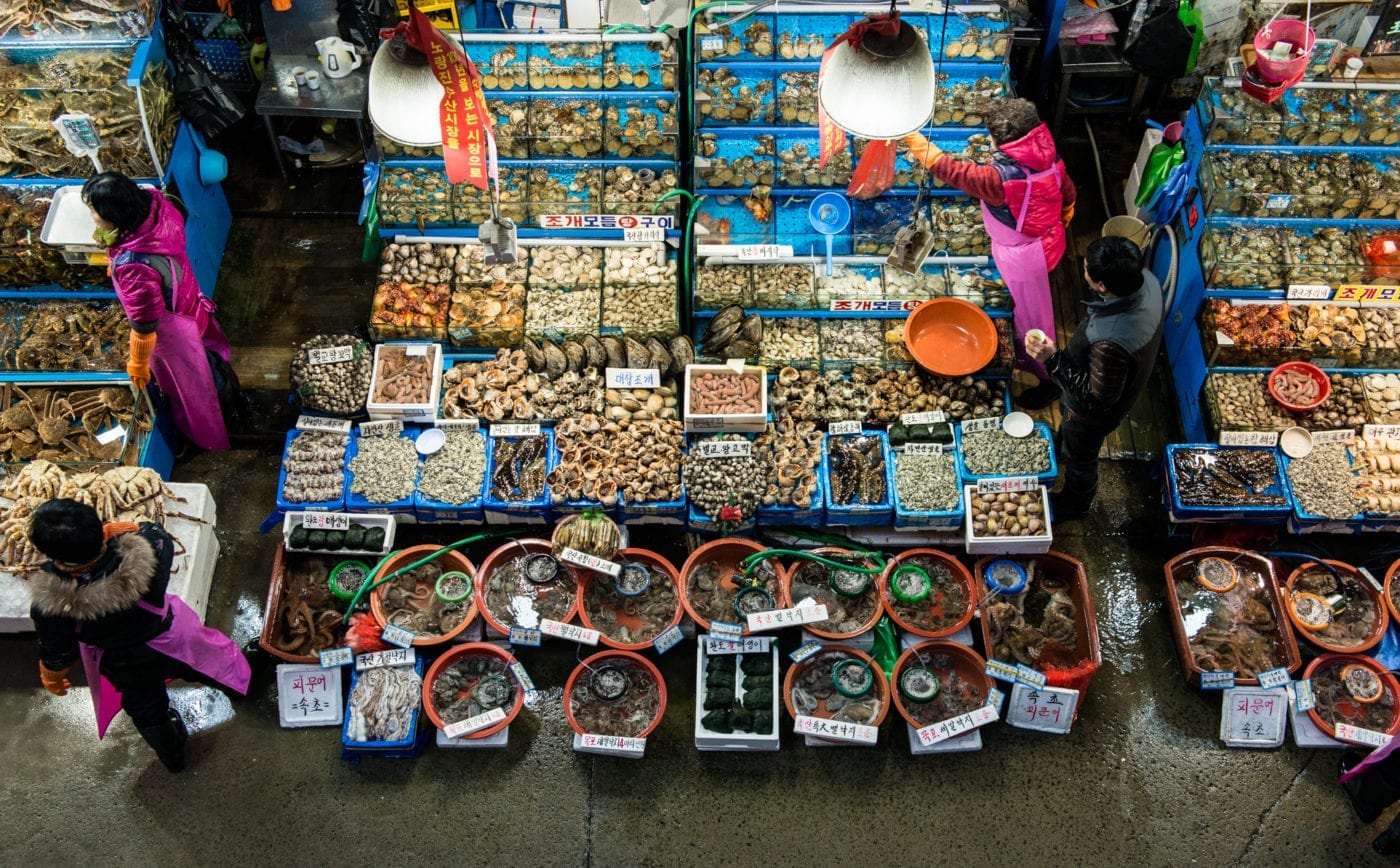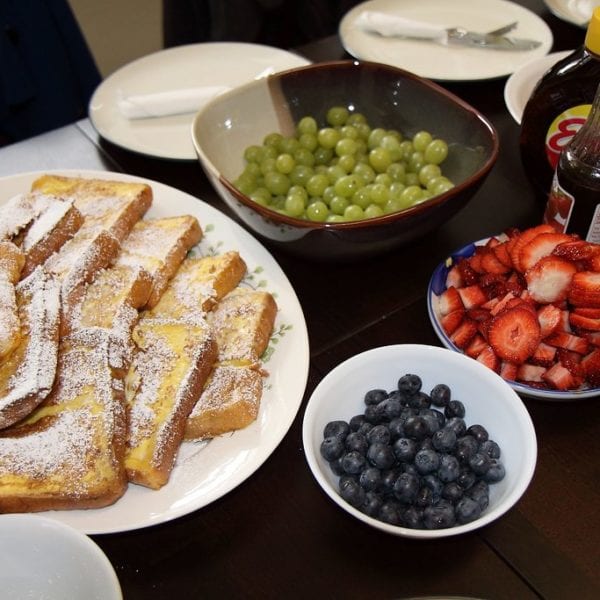From braving live octopus to slamming soju with the locals, eating street food at one of the many traditional markets in Korea can be a great way to connect with Korean people and food. But with so much to offer, it can be hard to know where to start. Follow our guide to ensure you make the best of bustling Korean market food scene.
Markets in Seoul
Gwangjang Market (광장시장) | Jongno-gu, Seoul
Located at the eastern end of Jongno, this lively cloth and textiles market has been doing brisk trade for over 100 years. From Monday to Saturday, the main concourse comes alive as dozens of vendors get to work serving everything from boiled pig trotters (jokbal, 족발) to steamed blood sausage (sundae, 순대).
It’s all worth exploring, but for guaranteed quality eat at one of the mungbean pancakes (bindaetteok, 빈대떡) stalls. These thick, hash brown-like pancakes are made from a rich batter of crushed mung beans, bean sprouts and cabbage.
Bindaetteok tastes great dipped in soy sauce and is traditionally accompanied by traditional Korean rice beer (makgeolli, 막걸리). Another dish worth trying here is barley bibimbap. To make it, measured amounts of gochujang, sesame oil and doenjang are mixed with rice, barley, dried seaweed and an abundance of fresh leaves and vegetables.
The dish is all about balanced flavors and freshness and qualifies as some of the best bibimbap in the city.
Hours: The market is open from 7 am to 7 pm, but the food stalls stay open until around 11 pm. Closed Sundays.
Prices: Bindaetteok: W4,000; barley bibimbap: W4,000.
For more street foods try, check out 9 Street Foods You Have to Try in Korea.
Noryangjin Fish Market (노량진 수산시장) | Dongjak-gu, Seoul
This expansive fish market is a great place to sample some of the freshest seafood in Seoul. The 66,000 m2 complex contains some 400 individual stalls, and functions as both a wholesale auction and a direct retail business.
Dozens of restaurants line the market’s fringes, and most of them will happily prepare anything purchased from the market floor for a small fee. Almost every type of seafood imaginable can be found at Noryangjin, but if you’re having trouble deciding, the baby octopus (jjukkumi, 쭈꾸미) and shrimp (saeu, 새우) are good options.
The baby octopus is served still wriggling with sesame oil and gochujang, while the shrimp are grilled in their shells and sprinkled with salt. Both make for a truly memorable dining experience.
However, most diners come to Noryangjin for raw fish (hoe, 회). After a little negotiation, your fish of choice can be killed, gutted, and cleaned before being sliced up and served with leaves, soy sauce, and wasabi. As an added bonus, the leftover fish and bones are turned into a wonderful spicy fish broth (maeuntang, 매운탕) to finish off your meal.
Hours: Most shops are open from early in the morning until 9 pm. Restaurants stay open until midnight.
Prices: Baby octopus: W10,000 for 3; shrimp: around W15,000 per kilo; raw fish: prices start at around W40,000 – 60,000 per fish.
Namdaemun Market (남대문시장) | Jung-gu, Seoul
Namdaemun market is Seoul’s largest market selling a huge variety of inexpensive clothes, kitchenware and imported products. Almost every type of Korean street food can be found here, but the market is known for two dishes in particular: kalguksu (칼국수) and steamed hairtail fish soup (galchi jorim, 갈치조림). Kalguksu Street is located near Gate 6 of the market and features a dozen or so snugly packed food stalls inside a warm, covered alleyway.
For this traditional summer dish, knife-cut noodles are served in a warm broth loaded with chili, dried seaweed and thinly sliced vegetables. Gochujang adds a little spice to the dish while dried shrimp give it a subtle seafood depth that intensifies towards the bottom of the bowl.
Venturing further into the market, visitors can try galchi jorim in the atmospheric Galchi Alley. This narrow, hidden alleyway is a favorite of Japanese tourists and features several restaurants serving the delicacy in well-worn, battered pots. Of these Huirak (희락) is consistently popular and a good choice.
It may take a little patience to separate the meat from the bones, but you’ll be glad you made the effort; galchi jorim stands alone in Korean cookery with its thick, sweet, spicy sauce and huge slices of cooked radish.
Getting There: Take line 4 to Hoehyeon Stn. and get out at ex. 5. Kalguksu Street is directly across from the exit. To get to Galchi Alley, walk down into the market and take the third left, then turn right into the alley.
Hours: Kalguksu Street is open from 6 am till 9 pm and Galchi Alley is open from 3 am until 9 pm.
Prices: kalguksu: W4,000; galchi jorim: W7,000.
Gongdeok Market (공덕시장) | Mapo-gu, Seoul
The area around Gongdeok Station is known for the quality of its food, and Gongdeok Market is no exception. Although the produce on sale here is much the same as any local market, the cooked food section is in a league of its own. That’s because Gongdeok Market is home to Jokbal Alley and Jeon Alley.
These twin institutions inhabit a tight network of restaurants and corridors on one side of the market. Jokbal Alley specializes in mammoth plates of the eponymous jokbal (족발), a pork dish made by boiling pig trotters in soy sauce and spices.
The jokbal arrives sprinkled with sesame seeds and is accompanied by a spicy pork broth, steamed blood sausage and a salty shrimp dip called saeujeot (새우젓). The result is a salty, fatty, spicy feast fit for a king.
If that isn’t enough, then a stop by Jeon Alley should definitely fill you up. In addition to various Korean-style pancakes (jeon 전), they serve a huge array of fried snacks (twigim 튀김), similar to Japanese tempura.
The best thing to do is to grab a basket and load up on what you like the look of – everything will be finished in the fryer and served piping hot.
Getting There: Take line 5 or 6 to Gongdeok Stn. and get out at ex. 4. The food alleys will be on your right as you walk through the market.
Hours: The food section is open late throughout the week.
Prices: jokbal: W16,000 for a small portion, W20,000 for a big portion; twigim: between W400 – 700 a piece.
Hyewha Sunday Filipino Market | Jongno-gu, Seoul
Despite continued attempts by local authorities to narrow its size and scope, the Hyewha Filipino Market remains a great place to try authentic Filipino food. The market has been running for 15 years and primarily serves the needs of Seoul’s sizable Filipino community, but everybody is welcome.
In addition to Filipino goods and sundries, a wide range of food is available that includes fatty longganisa sausage, spring rolls and curries. A good option is the curry plate, which comes with a rotating selection of sweet, creamy curries that will transport your taste buds to South East Asia.

While there be sure to grab yourself an empanada or two as well – these samosa-like pastries are stuffed full of tasty meat, potatoes and vegetables and make for ideal munching food as you browse the unusual vegetables and imported products.
Getting There: Take line 4 to Hyewha Stn. and get out at ex. 1. The market is a few minutes’ walk from the exit.
Hours: The market is open on Sundays from 9:00am till 5:00pm. Peak time is around 3:00pm.
Prices: Mixed curry plate: W6,000, spring rolls: W1,000; empanada: W1,000.
Garak Market | Songpa-gu, Seoul
Located near Jamsil in southeast Seoul, this is the largest market in Korea selling marine, agricultural and livestock products. It has a good seafood section and is a great place to buy fruit and vegetables in bulk.
Markets in Korea (Outside Seoul)
Try the following markets in Korea for more fantastic market food.
Moraenae Market | Incheon, Gyeonggi Province
The specialties here are naengmyeon and seafood.
A taxi ride away from Incheon City Hall Stn. (Incheon line 1). imoraenae.com
Chuncheon Romantic Market | Chuncheon, Gangwon Province
The region’s largest market, this one’s famous for featuring over 30 dalkgalbi restaurants.
The market is located in Chuncheon Town Centre.
Jungang Market | Daejeon, Chungcheong Province
A lively food market with a range of stalls.
The market is located in Dong-gu in front of Daejeon Station.
Jagalchi Market | Busan, Gyeongsang Province
Korea’s largest seafood market features a huge selection of fish, crab and shellfish. Also see the article on the next page. Take subway line 1 to Nampo-dong Station (exit 2) or Jagalchi Station (exit 10). jagalchimarket.org
Seomun Market | Daegu, Gyeongsang Province
A variety of cooked food, fruit and vegetables.
Near Seaomun Market Station (line 2, exit 1).
Yangdong Market | Gwangju, Jeolla Province
Sample some of Gwangju’s famous food at this traditional market.
Next to Yangdong Market Station 062-366-0884
Dongmun Market | Jeju City, Jeju Island
With top-class seafood including abalone, top shell and octopus. Just east of the airport.
Have you visited any of these markets in Korea? Leave a comment below! You can also check out 6 Night Markets In Seoul You Should Stay Up For.






